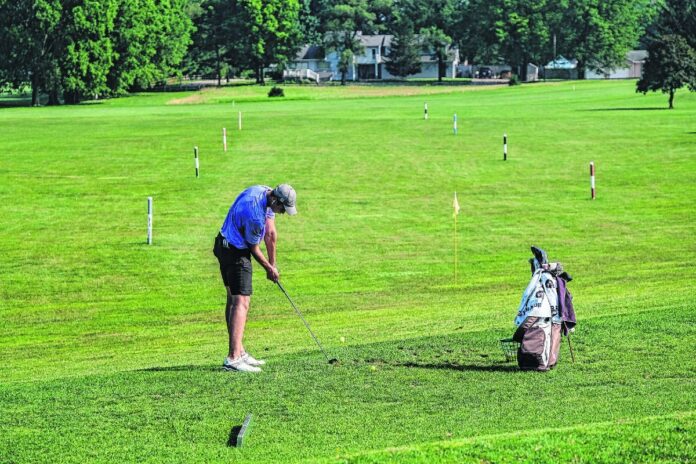
A year ago, city officials presented the possibility of closing Greenbelt amid financial difficulties with Columbus’s three city-run golf courses.
Now, after several city meetings, countless public comments and a $176,000 subsidy, the course is still open, as are Par 3 and Otter Creek.
City golf courses are likely to be discussed as part of the city’s budgeting process, said Associate Director of Recreation Nikki Murphy with the Columbus Parks and Recreation Department. The department manages Greenbelt and Par 3, whereas Otter Creek is managed by a city-appointed board.
All three courses are doing considerably better than last year in terms of revenue. According to data provided by the parks department, at the end of May, Greenbelt was up about $57,000 in revenue from the same time last year, and Par 3’s revenue was up about $12,000. Otter Creek General Manager Wiley Umphress reported that the course’s revenue, through the end of June, is up almost $300,000 from the same time last year.
Budget discussions will include a culmination of data gathered and reviewed by a city-appointed community golf working group, which was created to “collect data and benchmark other areas in the state of Indiana with similar cities and/or courses to Otter Creek, Greenbelt and Par 3.”
This includes examining their golf subsidy, number of holes, business practices and management structure.
The working group was also established to “evaluate golf as a whole for the entire community, as it pertains to city-owned courses” and provide data to help city administrators form a plan, she said.
Murphy, who has been involved with the group, said that their benchmarking has shown that other areas have the same struggles of Columbus, in terms of also having to subsidize their courses, being uncertain about up and down golf trends, and wanting more information.
“Everybody’s waiting for the next person to figure out the best solution possible, but everybody’s in the same boat,” she said.
Murphy has also played a role in the city’s Golf Course Advisory Committee, which was created to set and help achieve goals for Greenbelt and Par 3. The committee works with the parks department and helps with fundraising, new programming, marketing and setting fees.
The committee set three goals for the two courses: increase revenue, increase the number of rounds, and increase junior play.
On the revenue side, the parks department is doing 11% better than 2017, its best year since resuming control of the two courses in October of 2015, said Murphy. This is despite have zero rounds in February due to adverse weather.
The increase in revenue is due to both new play and a focus on sponsorships, she noted, as well as the return of programs previously shut down by COVID-19, which has also helped with rounds. Some fees were increased as well.
“One of the biggest differences, this year, is we were able to retain, to date — there’s other opportunities coming — but to date, about $5,000 in sponsorships,” she said. “Whereas in the past, it was typically only around $1,000 a year.”
To help increase rounds, the city created a beginner golf clinic and a junior golf league. They’ve also been able to increase the number of people playing in their weekly leagues.
Murphy said that focusing on marketing toward “missing demographics” in the age range of 25-40 years old has been important for increasing play.
“We’ve actually been able to notice the difference in terms of the customers who are coming in,” she said. “There’s more unfamiliar faces … people who are not members that are actually paying to play that we have not had the pleasure of serving before. So we know that the marketing is working.”
Another missing demographic is younger golfers, Murphy said, hence the focus on upping junior play. They’ve gone about this by implementing a “kids play free” program on Tuesdays, lower-price junior memberships at both courses and lower junior pricing at Greenbelt.
In general, Murphy said that since the city decided to keep Greenbelt open another year, it seems like the community has had an “eye-opening experience” and is showing its support for the courses.
“It was obviously a trying year while we’re trying to work through all of this, but I think that the community has come out tenfold,” Murphy said. “So it has been nice.”
She credited golf staffers for working with the new programs and creating a “welcoming atmosphere” for different skill levels and demographics.
“We’re meeting and exceeding the goals that we had set for ourselves,” she said. “And we found a lot of really great support from the advisory committee. I really just can’t give them enough credit. They dug in with us throughout this process, and I think that made a huge difference. And so the level of support has been pretty fantastic.”
At the moment, the department is moving forward and planning on golf at both courses next year, Murphy said.
Umphress reported that Otter Creek is also doing well, with 16,246 rounds of golf through the end of June.
The course’s revenue is up almost $300,000 from the same time last year, and greens fees are up $120,000.
“June is the only month in which we didn’t hit our numbers and weather was a major factor,” he said.
The course had 33,000 rounds of golf in 2020 and expect to approach the same number again, though weather will play a role in how things turn out.
For instance, Umphress said the course was briefly unplayable due to flooding a few weeks ago. However, he added that the grounds crew did a “phenomenal” job of cleaning it up.
Their hard work, along with that of the restaurant staff, have contributed to higher revenue in 2021, he said.
The course has also partnered with the visitors’ center and local hotels to provide “stay and play” packages, and out-of-town play is “booming,” Umphress said.
2021 has also seen a return of events cancelled during the previous year.
“COVID didn’t allow many of our corporate outings to play in 2020,” Umphress said. “This year, we have 23 outings and tournaments on the schedule. I am very proud of our staff in that the feedback we receive from these tournaments and outings is always very positive whether it pertains to the golf course, staff, or food and beverage.”
[sc:pullout-title pullout-title=”By the numbers” ][sc:pullout-text-begin]
Greenbelt (through the end of May 2021)
2021 year-to-date revenue: $119,646.85
2020 YTD: $62,250.79
2021 YTD total rounds played: 4,607
2020 YTD: 3,401
Par 3 (through the end of May 2021)
2021 YTD revenue: $17,834.64
2020 YTD: $5,624.50
2021 YTD total rounds played: 2,463
2020: 734
Otter Creek (through the end of June 2021)
2021 YTD revenue: $913,075
2020 YTD: $618,870
2021 YTD total rounds played: 16,246
[sc:pullout-text-end][sc:pullout-title pullout-title=”Timeline” ][sc:pullout-text-begin]
January 2020: Cummins decides to reduce its involvement in the Otter Creek Management Corp., and the city assumes full control of Otter Creek Golf Course. Mayor Jim Lienhoop notes that when Otter Creek, Greenbelt and Par 3 are added up, this means that 54 holes of golf are available — which, he says, “Intuition tells us that may be a little bit more than we need.” The city decides to work with Tobi Herron, president of Inspire Motive LLC and former Otter Creek board member, and look Otter Creek’s data, industry trends and how golf offerings will look in Columbus in the future.
July 2020: At a public meeting in The Commons, the possibility of closing Greenbelt is presented by city officials as the best option for dealing with financial difficulties facing the city’s golf courses. Following the presentation, several individuals speak up during the time for comment/Q&A, vehemently opposing closure of the course. The city decides later that month to look into other options more and do further research.
August 2020: The city releases an RFP for a private operator to take over management of Greenbelt. The deadline passes with no offers submitted, despite some interested parties attending a site visit.
September 2020: The Columbus Parks Board approves a 2021 general fund budget with no golf funding and announces its plans to exit golf, close Greenbelt and leave management of Par 3 to the Otter Creek management team — however, they say they’ll reconsider if Columbus City Council provides an additional $176,000 for golf expenses.
October 2020: City council votes to provide the necessary funding, and its members say that Greenbelt’s future will likely depend on the community support it receives. The city also decides to set up a golf advisory committee to look at and seek to improve course operations.
[sc:pullout-text-end]




